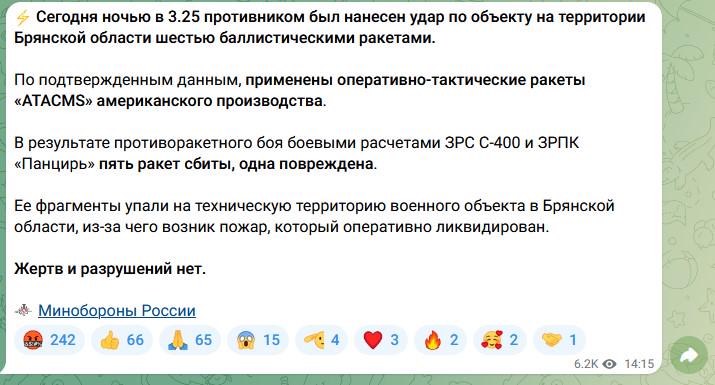

So far the only video available is of a hit on a reported mayonnaise factory (though some sources say it could also be a drone factory).
Imagine WW3 starting because Ukraine bombed a mayonnaise factory…
I don’t know what this is


So far the only video available is of a hit on a reported mayonnaise factory (though some sources say it could also be a drone factory).
Imagine WW3 starting because Ukraine bombed a mayonnaise factory…


Large scale Ukrainian drone attack against Russia is currently underway, over 40 drones reported to be shot down. Over 30 were over Bryansk, the oblast that Ukraine used ATACMS against last night/early morning. So far only Ukrainian UAVs. If Ukraine launches ATACMS as part of these attacks, it could get bad, but I don’t think the Ukrainians are that suicidal…
Twitter Source and the same source on xcancel.
This is the same source that correctly reported on Russia’s attack on Ukrainian electrical infrastructure as it it happened a few days ago.


Attacking Ukrainian electrical infrastructure already started with the big attack a few days ago, even to the point that 7 out of 9 Ukrainian nuclear power plants (NPPs) had to reduce output to between 40-90% of their usual output. The first time this happened in the war. In fact, I’d argue that the US lifting the restrictions on ATACMS is likely in response to this new stage of the de-electrification campaign by Russia against Ukraine. So you’re right in that they could continue it with more strikes, but I’d argue that was already planned.
The hard limit to any de-electrification campaign is that Russia cannot strike the sources of off site power for the NPPs to the point that the NPPs lose external power completely, that would be very dangerous as it’s required for proper reactor cooling.


The real issue is that these types of long range missiles can carry a nuclear payload. If Russia detects that a bunch of nuclear capable missiles are flying to Russia then they have to make call on whether it is a genuine nuclear first strike or just a conventional weapons attack.
There’s no known nuclear version of ATACMS, and even if we go by this logic Ukraine could also claim that they don’t know if Russian Kh-101s carried by Tu-160 bombers (part of Russia’s strategic nuclear forces) are nuclear armed or not, so they don’t know if they’re under nuclear attack or not.
The real issue with ATACMS missiles being used to attack Russian territory, as explained by Lavrov today and Putin earlier, is that it relies on US and NATO satellites for guidance, and US/NATO specialists to input attacking information and flight paths. So in essence, you have US military specialists and assets directly taking part in conducting strikes on Russian territory and military facilities within Russia. Something that didn’t even happen during the cold war. That’s what makes it a huge escalation.


Yeah the quality of the domestic league does still matter of course, to give talents a place to showcase their skills in the first place. And in every continental competition that’s not the Euros or Copa America, you can get very far using players from your domestic league. South Africa came third in the last AFCON using mostly players that play in South Africa, for example. But the Chinese domestic league has made many mistakes (chasing washed up players from top leagues on high wages before even building a good base, for example), and their academies can’t produce good talents.


but they just can’t seem to figure out football for some reason.
They need to get their players to play in the top 5 European leagues, it’s the only way to compete at the highest level on the international stage nowadays. Domestic leagues just don’t have high enough quality football to develop and improve players. Iron sharpens iron at the end of the day.


The reason the INF was even signed is because these are the riskiest platforms to actually field and maintain, the INF still allowed sea and air launched short/intermediate ranged ballistic missiles.
Well yes, no one wants nuclear weapons stationed on their land border. It’s an extremely high risk scenario. So both sides at the time could agree to take these weapons out of service. Banning sea launched nuclear weapons would be an impossibility given the existence of submarines, no side would willingly give up their second strike capabilities. And air launched ballistic missiles were not operational as of 1991, the US had only conducted a few experiments and the air launched version of what became the ATACMS programme was scrapped. The Kinzhal only became operational as of 2022. Nuclear air launched cruise missiles were not going to be banned, as that was important for both sides strategic bombers.
Ultimately the treaty was not going to last with only the US and Russia being members, it’s gives a superpower like China a huge advantage in this field. Even a country like Iran has developed IRBMS/MRBMs which don’t have a direct NATO or Russian counterpart currently in service. There’s also the plans around the “NATO missile defense system” that basically killed the deal. If one side builds missile defences, the other side is going to look to construct weapons that can bypass them, to keep the playing field level. Any future treaty would have to ban the deployment or construction of certain advanced missile defence systems to be viable.


When looking at ground based systems, we can look at the Serbs again in this regard. They rejected the S-400 systems for highly mobile Chinese HQ-22 systems. Many, including me, were perplexed by such a decision. The HQ-22 is inferior to the S-400 in almost every area, except one: mobility and footprint. But now, given current events and the experience the Serbs had against a modern NATO SEAD/DEAD campaign, it makes sense. They prioritised mobility above everything else.


AFAIR NATO countries haven’t ever fielded TCMBs with nuclear warheads on mobile land platforms due to the risk
There was Pershing Ia and Pershing II which had nuclear warheads, but they are no longer in service. They were stationed in Europe, West Germany in particular had a lot of mobile sites, mounted on MAN M1001 vehicles. Pershing II was a particularly scary missile as it had a MaRV (Maneuverable Re-entry Vehicle) back in the 1980s. It’s basically the father of all modern tactical ballistic missiles. No air defence system from that time was intercepting that. Even the most sophisticated modern missile defence systems, such as Arrow 2 and Arrow 3 in Israel, still struggle to intercept MaRVs, as shown by Iran’s October 1st retaliatory strike.
The reason we haven’t seen this after 1991, and why the US and Russia have not focused much on short, medium and intermediate range ballistic missiles since then, is due to the INF treaty. However, the US withdrew from this treaty during 2018 and 2019.


Transfer satellite control to some group that is hostile to the US
Russia already has reportedly shared satellite data/imagery with Ansar Allah/The Houthis before, first giving it to Iran, who passed it on to them.


The only F-35s with Air Launched Ballistic Missiles (ALBMs) are the Israeli F-35s with the ROCKS missile, the US F-35s have the AGM-158 JASSM and LRASM cruise missiles as standoff weapons, and cannot carry them in the internal weapons bays, and only on external pylons. Realistically, one F-35 can only carry 2 AGM-158s (it has only been pictured carrying two at a time) or ROCKs missiles at a time on external pylons, given that these are large heavy missiles with a large aerodynamic footprint. So that’s 3 F-35s for six missiles. The smaller SPEAR 3 cruise missiles, designed to be carried internally, are still in development, and are much smaller weapons, more similar to 100kg glide bombs than large cruise or ballistic missiles.
Realistically, a stationary air defence system versus modern SEAD/DEAD tactics is a sitting duck, eventually it will be taken out, the aircraft always have the advantage. The key to survivability for air defence is to be mobile, as shown by the Serbs.


Yeah I saw the MoD statement and added it to the initial post. Apparent footage shows a large explosion though, could be a secondary explosion from debris, or a direct hit.


No modern air defence or missile defence system in the world is able to deal with modern day ballistic missiles when fired at a large enough volume, with quasi ballistic manouvers (in the case of ATACMS and Iskander-M) and Maneuverable Re-entry Vehicles (MaRVs) capable of performing skip and glide trajectories/pull up manoeuvres and pseudo random evasive maneuvers, in the case of modern Iranian missiles, such as the Kheibar Shekan series, and Fattah-1. We’ve seen Patriot PAC-3 systems been destroyed by Iskanders and Kinzhals, and S-300 and S-400 systems been destroyed by ROCKS (in Iran) and ATACMS.
Modern ballistic missiles (both air launched and ground launched) travel faster than ever inside the earth’s atmosphere, are capable of high accuracy even in GPS denied environments (in the case of US systems with highly accurate inertial guidance, Israeli systems with anti radiation seekers, and short range Iranian systems with EO seekers), and can manouver in non ballistic ways. It’s just going to get even worse for air defence once hypersonic glide vehicles (HGVs) enter service. India just tested an Anti Ship HGV a few days ago.


Iran could also get the bomb, and/or North Korea could get a miniaturised version of the bomb for use in their Short Range Ballistic Missiles (SRBMs) and for MIRV warheads for their new ICBM with over 15 000km range.
I think Ansar Allah/The Houthis getting advanced anti ship supersonic cruise missiles is the most likely option, Hezbollah got 12 of them at one stage.


This has been part of Zelensky’s five and ten point plans for a while. He really is that delusional.


As I learnt a long time ago, if you don’t laugh, you’ll cry.
Also technically did both the theory and praxis, he wrote a book about bombing Russian oil and gas pipelines, and then he actually did it with regards to Nordstream.
did both the theory and praxis, he wrote a book about bombing Russian oil and gas pipelines, and then he actually did it with regards to Nordstream.
I am also very worried to be honest.


 and
and  wrote the theory,
wrote the theory,  and
and  do the praxis.
do the praxis.


When Waterkloof Air Force Base and Makhado Air Force Base eventually get nuked during the eventual nuclear exchange, I’m going to enjoy seeing the nuclear hellfire live before my painful and hellish death. Maybe I’ll just watch up close from the hillsides so I’ll die instantly, seems like the best way to go.


In all seriousness though, this is very worrying.


Ukraine just hit a military installation in Bryansk with ATACMS missiles in the early hours of this morning, five intercepted but one got through according to the Russian MOD. Putin has also signed Russia’s updated nuclear doctrine into law, allowing for a nuclear response to a large scale non nuclear attack by a non nuclear state, aided by a nuclear state.
Russian MoD statement:

Tonight at 3.25 a.m. the enemy struck a facility on the territory of the Bryansk region with six ballistic missiles.
According to confirmed information, American-made ATACMS operational-tactical ballistic missiles were used.
As a result of an anti-missile battle by S-400 SAMs and Pantsir SAMs, five missiles were shot down and one was damaged.
Its fragments fell on the technical territory of a military facility in the Bryansk region, causing a fire, which was promptly extinguished.
There were no casualties or damage.
Russian Ministry of Defence
The statement appears in contradiction with the latest video from the area, showing a clear explosion. It seems as if the damaged missile got through for a direct hit. Or there were some secondary explosions from debris. Either way, there is clear damage done should the footage be legitimate.
Honestly had no idea. In that case, protect the mayo factories at all costs!
But seriously I just hope the Ukrainians don’t use ATACMS simultaneously with drone attacks. That would complicate matters, to say the least.